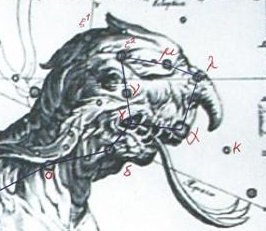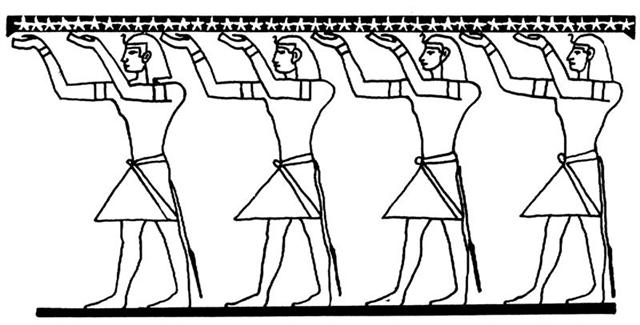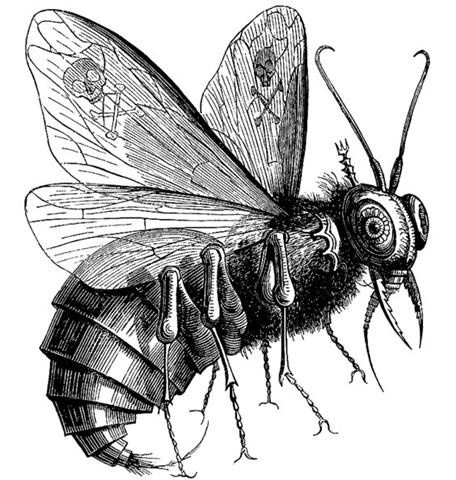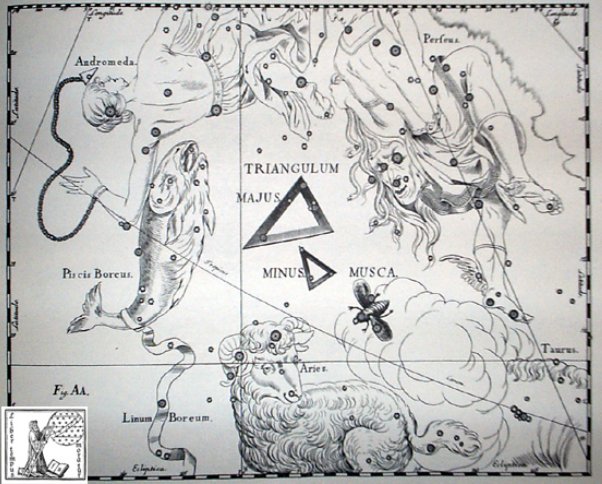From Mira (*33) to Bharani (*41) there were 8 right
ascension days, similar to the number of those dark
nights before Venus would return as morning star.
|
SYNODIC CIRCUIT OF VENUS |
|
Black |
8 |
|
Morning Star |
263 |
|
Black |
50 |
|
Evening Star |
263 |
|
Sum |
584 |

|
32 he tahe |
MIRA (*33) |
34 he taha |
35 he apuka |
|
...
Although an old
constellation, Cetus is by
no means of special
interest, except as
possessing the south pole of
the Milky Way and the
Wonderful Star, the variable
Mira; and from the fact that
it is a condensation point
of nebulae directly across
the sphere from Virgo, also
noted in this respect
...
...
Mira also known as
Omicron Ceti
(ο
Ceti, ο
Cet), is a red giant star
estimated 200-400 light
years away in the
constellation Cetus. Mira is
a binary star, consisting of
the red giant Mira A along
with Mira B. Mira A is also
an oscillating variable star
and was the first
non-supernova variable star
discovered, with the
possible exception of Algol.
Apart from the unusual Eta
Carinae, Mira is the
brightest periodic variable
in the sky that is not
visible to the naked eye for
part of its cycle ...
... In
1638 Johannes Holwarda
determined a period of the
star's reappearances, eleven
months; he is often credited
with the discovery of Mira's
variability. Johannes
Hevelius was observing it at
the same time and named it
'Mira' (meaning 'wonderful'
or 'astonishing,' in Latin)
in 1662's Historiola
Mirae Stellae, for it
acted like no other known
star. Ismail Bouillaud then
estimated its period at 333
days, less than one day off
the modern value of 332
days, and perfectly
forgivable, as Mira is known
to vary slightly in period,
and may even be slowly
changing over time
... |
|
FEBR 17 (14 * 29½) |
18
(414 = 365 + 49) |
19 (50) |
20 (*336 = 4 * 84) |
 |
 |
 |
 |
|
Gb7-30 (440 = 229 + 211) |
Gb7-31 (63 weeks) |
Gb8-1 |
Gb8-2 (214) |
|
ξ¹ Ceti (32.1) |
γ,
δ
Trianguli (33.0),
χ
Persei (33.2),
10 Trianguli
(33.5),
θ
Arietis (33.3),
MIRA
(Next to the Pleiades) =
ο
Ceti
(33.7) |
no star listed (34) |
ξ Arietis (35.0), ρ Ceti
(35.4),
12 Trianguli (35.8), ξ² Ceti (35.9)
*360.0 = *35.4 - *41.4 |
|
April 22 (477) |
23 (113) |
24 (*399) |
25
(115) |
|
°April 18 (473) |
19 (*29) |
20 |
21 (111) |
|
'March 26 (450) |
27 (*53 weeks) |
28 (*372) |
29 (88 = 115 - 27) |
|
"March 12 (436) |
13 (*51 weeks) |
3-14 (73) |
Tara-hao
15 |
|
Tara. 1. Thorn:
tara miro. 2. Spur:
tara moa. 3. Corner;
te tara o te hare,
corner of house; tara o
te ahu, corner of ahu.
Vanaga. (1. Dollar; moni
tara, id.) 2. Thorn,
spike, horn; taratara,
prickly, rough, full of
rocks. P Pau.: taratara,
a ray, a beam; tare,
a spine, a thorn. Mgv.:
tara, spine, thorn,
horn, crest, fishbone. Mq.:
taá, spine, needle,
thorn, sharp point, dart,
harpoon; taa, the
corner of a house, angle.
Ta.: tara, spine,
horn, spur, the corner of a
house, angle. Sa.: tala,
the round end of a house.
Ma.: tara, the side
wall of a house. 3. To
announce, to proclaim, to
promulgate, to call, to
slander; tatara, to
make a genealogy. P Pau.:
fakatara, to enjoin.
Mq.: taá, to cry, to
call. 4. Mgv.: tara,
a species of banana. Mq.:
taa, a plant, a bird.
Ma.: tara, a bird. 5.
Ta.: tara,
enchantment. Ma.: tara,
an incantation. 6. Ta.:
tara, to untie. Sa.:
tala, id. Ha.: kala,
id. Churchill.
Hao.
Ta.: to encircle. To.:
hao, id. Ma.: hao,
to inclose, to draw around.
Churchill.
 |
|
CLOSE TO THE FULL MOON: |
|
AUG 19 (231) |
20 (*152) |
21 |
22 |
|
Al Ghafr-13 (The Cover) /
Svāti-15 (Very Good) /
TAHUA-TAATA-METUA-TE-TUPU-MAVAE-6
(a pillar to stand by)
15 Bootis
(215.2),
ARCTURUS
=
α
Bootis
(215.4),
ASELLUS SECUNDUS (2nd Ass
Colt) =
ι
Bootis
(215.5),
SYRMA (Train of the Virgin's
Robe)
=
ι
Virginis,
λ
Bootis (215.6),
η
Apodis (215.8)
*174.0 = *215.4 - *41.4 |
ι Lupi, 18 Bootis (216.3), KHAMBALIA (Crooked-Clawed)
= λ Virginis
(216.4), υ Virginis (216.5),
ψ Centauri (216.6), ε Apodis
(216.8)
*175.0 = *216.4 - *41.4 |
ASELLUS PRIMUS (1st Ass
Colt) =
θ
Bootis
(217.8) |
τ
Lupi,
δ
Oct. (218.1),
φ
Virginis (218.7)
FOMALHAUT (α Piscis
Austrini) |
|
Oct 22 (295) |
23 |
24 |
25 (*218 = *177 + *41) |
|
°Oct 18 (291) |
19 |
20 |
21 (*214 = *177 + *37) |
|
'Sept 25 (*188) |
26 |
27 (270 = 3 * 90) |
28 |
|
"Sept 11 (254) |
12 |
13
(16 * 16) |
Hora nui
14 (*177) |
|
32 |
he tahe |
a Maeha. a Teke |
|
MIRA (*33) |
|
34 |
he taha |
|
35 |
he apuka |
|
36 |
he apuka heu |
|
37 |
he tuitui koviro |
|
38 |
he rai atea |
|
39 |
he rai atanga |
|
40 |
he ravi kana |
|
41 |
BHARANI (*41)
he ravi pako |
The name for the water yam type he rai atea
(*38) could have been applied in order
to allude to the Sky (Ragi)
becoming White (Tea). *38 + *183
= *221 (Toliman), i.e. day 118 + 183 =
301 could then correspond to the
opposite transformation when Atea
changed her sex from female to male:
Ragi. Ra'i, T. 1. Sky. 2. Palace. 3.
Prince. Henry. 1. Sky, heaven, firmament;
ragi moana, blue sky. 2. Cloud; ragipuga,
cumulus; ragitea, white, light clouds;
ragi poporo, nimbus; ragi hoe ka'i
cirrus (literally: like sharp knives); ragi
viri, overcast sky; ragi kerekere,
nimbus stratus; ragi kirikiri miro,
clouds of various colours. 3. To call, to shout,
to exclaim. Vanaga. 1. Sky, heaven, firmament,
paradise; no te ragi, celestial. 2.
Appeal, cry, hail, formula, to invite, to send
for, to notify, to felicitate, precept, to
prescribe, to receive, to summon; ragi no
to impose; ragi tarotaro, to menace, to
threaten; tagata ragi, visitor;
ragikai, feast, festival; ragitea,
haughty, dominating. 3. Commander. 4. To love,
to be affectionate, to spare, sympathy, kind
treatment; ragi kore, pitiless; ragi
nui, faithful. Churchill. Modoc, a
language used on the northwest coast of North
America: 'A single word, lagi, was used
both for the chief and for a rich man who
possessed several wives, horses, armour made of
leather or wooden slats, well-filled quivers and
precious firs. In addition to owning these
material assets, the chief had to win military
victories, possess exceptional spiritual powers
and display a gift for oratory.' (The Naked Man)
Tea. 1. Light, fair, whitish. 2. To rise
(of the moon, the stars); ku-tea-á te hetu'u
ahiahi, the evening star has risen. Vanaga.
1. To shine, be bright, brilliant, white; tea
niho, enamel of the teeth; ata tea,
dawn; teatea, white, blond, pale,
colorless, invalid; rauoho teatea, red
hair; hakateatea, to blanch, to bleach. P
Pau.: faatea, to clear, to brighten.
Mgv.: tea, white, blanched, pale. Mq.:
tea, white, clear, pure, limpid. Ta.: tea,
white, brilliant. 2. Proud, vain, haughty,
arrogance, to boast; tae tea, humble;
teatea, arrogant, bragging, pompous,
ostentatious, to boast, to show off, haughty;
hakateatea, to show off. Mgv.: akateatea,
pride, vanity, ostentatious, to be puffed up.
Ta.: teoteo, boastful, proud, haughty. 3.
Mgv.: teatea, heavy rain. Ha.: kea,
the rain at Hana and Koolau.
Churchill. 1. White, clear; fair-complexioned
person, often favorites at court; shiny, white
mother-of-pearl shell, cfr. keakea,
kekea, Mauna Kea. Po'o kea,
towhead, gray-haired person. One kea,
white sand (this is shortened to ōkea or
kea, as in the expression kea pili mai,
drift gravel - vagabond). (PPN tea). 2.
Breast milk. See Nu'a-kea. 3. A variety
of sugar cane, among Hawaiians one of the
best-known and most-used canes, especially in
medicine: clumps erect, dense, of medium height;
pith white. Ua ola ā 'ō kō kea, living
until kea cane tassels (until the hair
turns gray). 4. Name listed by Hillebrand for
kolomona (Mezoneuron kavaiense); see
uhiuhi. Wehewehe. KEA. adj.
Haw., also keo, keo-keo, white,
lucid, clear; a-kea, openly, public;
au-akea, at noon, midday. Sam.:
tea-tea-vale, be pale; ao-atea,
forenoon; atea-tea, wide, spacious. Tah.:
tea, white; teo-teo, pride,
haughtiness; atea, clear, distinct, far
off. Marqu., tea, atea, white,
broad daylight, also name of the principal god;
light generally, as opposed to darkness. Fiji.,
cea-cea, pale, deathlike; cecea,
daybreak, light of morning. Malg., tziok,
brilliant, snowwhite. Ceram (Mahai), teen,
a star. Greek, θεος, m. θεα, f.
god, goddess, divinity generally. In Greek,
θεος signified no god in particular, but was
applied ot almost all the gods, though perhaps
more often to the sun. As the first gods were
the sun, moon, &c., their brilliancy and
whiteness were the underlying sense of the names
given them. That primary sense was apparently
lost in the Greek and the other West Aryan
branches, though in the Polynesian both the
primary and derivative sense has been preserved,
ans in the Marqu. atea, both god and
light, in the Tah. tapu-tea, the rainbow,
and the Sam. tapu-i-tea, the evening star
... Fornander.
... When this tremendous task
had been accomplished Atea took a third
husband, Fa'a-hotu, Make Fruitful. Then
occurred a curious event. Whether Atea
had wearied of bringing forth offspring we are
not told, but certain it is that Atea and
her husband Fa'a-hotu exchanged sexes.
Then the [male] eyes of Atea glanced down
at those of his wife Hotu and they begat
Ru. It was this Ru who explored
the whole earth and divided it into north,
south, east, and west ...
|
36
he apuka heu |
37
he tuitui koviro |
38
he rai atea |
|
Tui. 1.
To sew mats, to make
strings. E-tahi
tuitui reipá i Te
Pei, ekó rava'a
e-varu kaukau;
i-garo ai i Hiva, i
te kaiga, a
necklace of
mother-of-pearl is
on te Pei,
few will find it
(lit: eight groups
of people); it has
remained in Hiva,
in our homeland. 2.
The three stars of
Orion's Belt.
Vanaga. Mq.:
tuitui, be
still! Mq.:
tuitui kioé,
chain. |
|
FEBR 21 (417)
|
22 (53) |
TERMINALIA |
 |
 |
 |
|
Gb8-3 (229 + 215 = 444) |
Gb8-4 |
Gb8-5 (217) |
|
σ Ceti (36.9) |
ν Ceti (37.9) |
ν Arietis (38.5), δ,
ε Ceti (38.8) |
 |
|
April 26 (*36) |
27 |
28 (118 = 4 * 29½) |
|
°April
22 (*32) |
23 |
24 (*399 = 479 - 80) |
|
'March
30 (454 = 365 + 89) |
31 |
'April 1 (91) |
|
"March
16 (*360 = *36 - *41) |
Tara-hao
17 |
18 (77 = 91 - 14) |
|
CLOSE TO THE FULL MOON: |
|
AUG
23 |
24 (236 = 53 + 183) |
25 (*157) |
|
σ
Lupi (219.1),
ρ
Bootis (219.5),
HARIS (Keeper) = γ
Bootis (219.7) |
σ Bootis (220.2), η
Centauri (220.4)
*179.0 = *220.4 -
*41.4 |
ρ Lupi (221.0),
TOLIMAN
= α Centauri
(221.2), π Bootis
(221.8), ζ Bootis
(221.9) |
|
Oct
26 |
27 (300) |
28 (118 + 183) |
|
°Oct
22 (295) |
23 (*216) |
24 |
|
"Sept
29 (*192) |
30
(3 * 91) |
'Oct 1 |
|
Hora nui 15 (*178) |
"Sept
16 (236 + 23) |
17 (260) |
... From
the first star king (Hamal)
to the next (Alcyone) there
were 26 right ascension days
and if each of these 10 star
kings should have ruled for
26 days they would together
have covered 260 days of the
year ... This connects up
the present section with the
beginning of the 'sacred
tonalamatl', at the
Spring equinox with the
Mayas as with the Mexicans,
and in the center of the
364-day year (52 days of
which preceded and 52
followed the tonalamatl
or tzolkin), ruled by
its 91-day quarters by the
Four Bacabs, whose
quarternary repetition (in
the 1820-day period) we have
thus verified ...
|
52 |
260 = 5 * 52 |
52 |
|
364 = 4 * 91 = 7
* 52 |
... 1820
= 20 * 91, i.e. the
bacabs circulated 5
times in the 1820-day
period, 5 * 364 = 1820, and
7 * 260 also happens to be
1820. They were ruling the 4
quarters of a 364-day long
year, and in the center of
this year there were 260
days, the sacred
tonalamatl (tzolkin)
calendar, which began at
spring equinox:

|
39
he rai atanga |
40
he ravi kana |
BHARANI (*41)
he ravi pako
|
|
Kana. Le kana
est un crustacé dont
l'enveloppe
fournissait un
ornement nommé
Rei, comme la
planche représentant
un des longs côtes
d'un navire. La
femme représentée,
en Cook, avec le
chapeaux Poouo,
porte au core un
kana rei.
(Jaussen according
to Barthel)

Tuakana,
elder, elder
brother;
tuakana tamaahina,
elder sister. |
|
FEBR 24 (420) |
25 (56) |
26 (*342) |
 |
 |
 |
|
Gb8-6 (218) |
Gb8-7 |
Gb8-8 (449 = 229 +
220) |
|
μ
Arietis (39.4),
HEAD OF THE FLY
= 35 Arietis
(39.6),
KAFFALJIDHMA (Part
of a Hand) =
γ
Ceti,
θ
Persei (39.8)
*363.0
= *39.4 - *41.4 |
π
Ceti,
ο
Arietis (40.0),
ANGETENAR (Bend in
the River) =
τ¹
Eridani,
μ
Ceti (40.2),
RIGHT WING
= 39 Arietis
(40.9) |
Bharani-2 (Yoni) /
Stomach-17
(Pheasant)
π
Arietis (41.2),
MIRAM (Next to the
Pleiades) =
η
Persei
(41.3),
BHARANI = 41 Arietis
(41.4),
τ²
Eridani,
σ
Arietis (41.7) |
 |
|
April 29 |
30 (120) |
May 1 (*41) |
|
°April 25 (115) |
26 (*36) |
27 |
|
'April 2 (92) |
3 |
4 (*14 = *41 - *27) |
|
"March 19 (78) |
Tara-hao
20 (*364) |
0h |
|
CLOSE TO THE FULL MOON: |
|
AUG 26 |
27 (239) |
28 (*160) |
|
31 Bootis
(222.0),
YANG MUN =
α
Lupi
(222.1),
RIJL AL AWWA (Left
Foot of the Barker)
=
μ
Virginis
(222.5),
ο
Bootis (222.9) |
IZAR =
ε
Bootis
(223.0),
109 Virginis,
α
Apodis (223.3),
μ
Librae (223.8) |
Al Zubānā-14a
(Claws) /
Visakha-16 (Forked)
/
Root-3 (Badger)
ZUBEN ELGENUBI
(Southern Claw) =
α
Librae
(224.2),
ξ
Bootis,
ο
Lupi (224.5) |
|
Oct 29 (*222) |
30 |
31 (304) |
|
°Oct 25 (*218) |
26 |
27 (300) |
|
'Oct 2 (*195) |
3 |
4 (277) |
|
"Sept 18 |
Hora nui
19 (*182) |
20 (263) |

|










